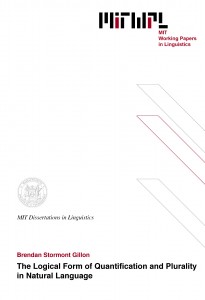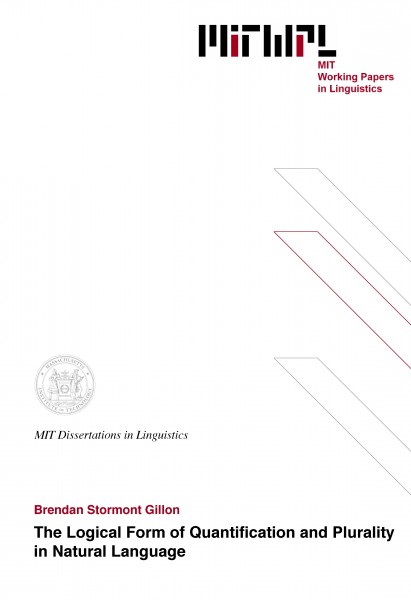The Logical Form of Quantification and Plurality in Natural Language
B. Gillon, 1984
The thesis is concerned with the logical form of sentences of natural language, in particular, with how quantificational aspects of sentences in natural language are to be represented in a theory of grammar. The question is explored with respect to a circumscribed, but interesting, class of sentences. The theory of grammar within which the question is pursues is a version of Chomsky’s theory of government and binding, as extended in recent work by Higginbotham. An especially important feature of the theory for the question treated is that syntactic and semantic principles are formulated in autonomous terms.
In the first chapter, the theory of grammar adopted for the analysis is outlined. A class of sentences, called “simple sentences”, is defined on a purely syntactic basis in the second chapter. Established in the course of defining this class is the fact that cardinal numberals are adjectives and not determiners (and hence, not quantifiers). The third chapter contains the semantic principles governing the interpretation of lexical items occurring in simple sentences. This leads, in the fourth chapter, to a statement of the recursive principles of interpretation for simple sentences. Included here is also a treatment of the semantics of the collective and distributive readings of plural noun phrases. This treatment elaborates earlier work by Higginbotham, drawing on data and insights from Langendoen and L. Carlson. The upshot is that an array of data, previously seeminly heterogeneous, is brought within the purview of a few simple principles, formulated in terms of the notion of a plurality cover, a kind of cover only slightly richer than a partition. In the fifth chapter, the previous analysis is extended to a still larger class of sentences, which contain so-called “floated quantifiers”, adjectival phrases, and prepositional phrases. This extension affords, in the sixth chapter, an analysis of sentences, which requires no such complication. Finally, in the conclusion, it is observed that for the class of sentences examined in the thesis, nothing more elaborate than standard restricted quantifiers is required to represent their quantificational aspects; in fact, it turns out, were higher order quantifiers adopted, as suggested by Langendoen and L. Carlson, to capture the semantics of plural noun phrases, or branching quantifiers, as suggested by Hintikka, to capture the alleged semantics of certain complex sentences, essential syntactic and semantic insights, which are independently grounded, would be jeopardized.
Thesis Supervisor: James Higginbotham
Title: Associate Professor of Linguistics and Philosophy
<br/>
Table of Contents
Introduction 8
Chapter One The Theory of Grammar and Logical Form 15
1.0 Introduction
1.1 The linguistic framework
1.2 The theory of Universal Grammar
1.2.1 DS to SS
1.2.2 SS and conditions on SS
1.2.3 LF and conditions on LF
1.3 Conclusion
Chapter Two The Syntax of Simple Sentences 56
2.0 Introduction
2.1 The simple noun phrase: syntax
2.1.1 The syntactic taxonomy of determiners
2.1.2 The syntactic taxonomy of nouns
2.1.3 Syntactic features and the noun phrase
Chapter Three The Semantics of Lexical Items 84
3.0 Introduction
3.1 Determiners interpreted
3.1.1 Demonstratives interpreted
3.1.2 Quantifiers interpreted
3.2 Nouns interpreted
3.2.1 Count nouns and proper names interpreted
3.2.2 Pronouns interpreted
3.3 Verbs interpreted
3.4 Conclusion
Chapter Four The Semantics of Simple Sentences
4.0 Introduction
4.1.1 Miscellaneous principles of interpretation
4.1.2 Simple noun phrases interpreted
4.2 Collective and distributed readings
4.3 Simple sentences interpreted
4.3.1 Simple sentences with reciprocal pronouns interpreted
Chapter Five The Semantics of Less Simple Sentences
5.0 Introduction
5.1 Q-float
5.2 The noun phrase revisited
5.2.1 Simple noun phrases with prenominal adjectives
5.2.2 Simple noun phrase with prepositional phrases
5.3 Conclusion
Chapter Six Hintikka and Branching Quantifiers
6.0 Introduction
6.1 The theory of branching quantifiers
6.2 Branching quantifiers and simple sentences
6.3.1 A case for branching quantifiers
6.3.2 Another case for branching quantifiers
6.4 Conclusion
Conclusion 226

